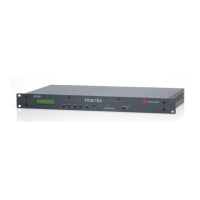TROUBLESHOOTING
VORTEX EF2201 Reference Manual 22 Technical Support: 800.932.2774
T
ROUBLESHOOTING
R
ESIDUAL
E
CHO
If there is residual echo in the system, it may not be a problem with the EF2201.
There are different types of echoes that come from different directions, and the
EF2201 is only designed to remove one of them. The first step is to make sure the
echo isn’t caused by something else. Then, the EF2201 can be adjusted to remove
any residual echo coming from the hybrid.
Identifying the Echo
Source
If the system has both audio and video conferencing, troubleshoot the system without
the EF2201 at first. This will make sure the 4-wire AECs on both ends are working
properly. If one side hears echo, there is a problem with the AEC on the other side.
Troubleshoot the AEC according to the instructions for that device.
Make a call to test the EF2201’s telephone interface. If the party on the phone hears
echo, it is coming from the local or remote end. Disconnect one end at a time (by
briefly unplugging the speaker or microphone) and see when the echo goes away.
Troubleshoot the AEC on the side (local or remote) that was causing the echo.
If residual echo is heard on the local end, try disconnecting the remote end. If the
echo is still there, it is coming from the EF2201. Troubleshoot the EF2201 as
described in the next section. If the echo goes away when the remote end is discon-
nected, troubleshoot the AEC on the remote end.
If residual echo is heard on the remote end, disconnect the microphone(s) in the local
room. If the echo is still there, it is coming from the EF2201. Troubleshoot the
EF2201 as described below. If the echo goes away when the microphone is discon-
nected, the echo is coming from the local room. Troubleshoot the local AEC.
Removing the Echo If the EF2201 is not removing hybrid echo, it may be due to a mismatch of levels
coming into the EF2201. If levels are too far off, it may be difficult for the EF2201 to
determine when to adapt its filter. Make sure the levels are in the correct range by
watching the front panel LED meters during normal conversation. The signals should
regularly be hitting the first yellow light, and occasionally flicker the second yellow
light. Adjust the incoming signal levels if necessary. Also, make sure the Line Echo
Cancellation feature is enabled.
C
AN
’
T
R
ECEIVE
C
ALLS
OR
D
IAL
O
UT
If you can’t receive calls or dial out, it could be because the telephone line is from a
digital PBX system, or the remote control system is not properly connected.
Test with an Analog
Phone
Try connecting a regular analog telephone to the EF2201’s line, and make a call. If
the telephone will not work on that line, it is probably a digital PBX line from an
office system. The EF2201 needs a standard analog line. You will need to get an
analog phone line installed for the EF2201.

